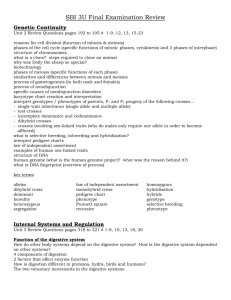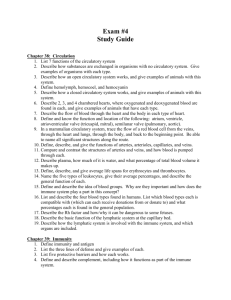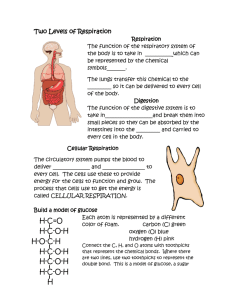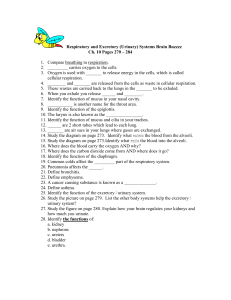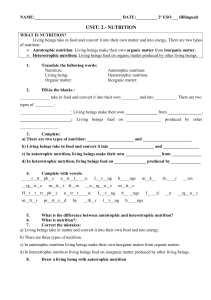SBI 3U Final Examination Review (units1to4) 2015
advertisement
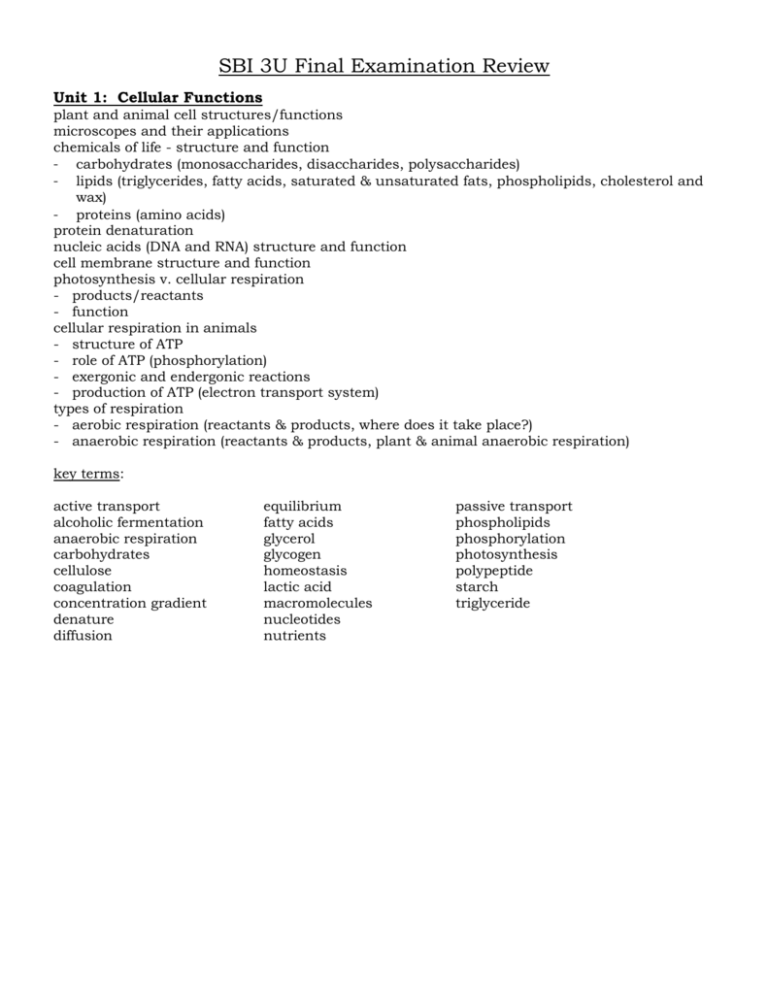
SBI 3U Final Examination Review Unit 1: Cellular Functions plant and animal cell structures/functions microscopes and their applications chemicals of life - structure and function - carbohydrates (monosaccharides, disaccharides, polysaccharides) - lipids (triglycerides, fatty acids, saturated & unsaturated fats, phospholipids, cholesterol and wax) - proteins (amino acids) protein denaturation nucleic acids (DNA and RNA) structure and function cell membrane structure and function photosynthesis v. cellular respiration - products/reactants - function cellular respiration in animals - structure of ATP - role of ATP (phosphorylation) - exergonic and endergonic reactions - production of ATP (electron transport system) types of respiration - aerobic respiration (reactants & products, where does it take place?) - anaerobic respiration (reactants & products, plant & animal anaerobic respiration) key terms: active transport alcoholic fermentation anaerobic respiration carbohydrates cellulose coagulation concentration gradient denature diffusion equilibrium fatty acids glycerol glycogen homeostasis lactic acid macromolecules nucleotides nutrients passive transport phospholipids phosphorylation photosynthesis polypeptide starch triglyceride Unit 2: Genetic Continuity cell theory reasons for cell division (function of mitosis & meiosis) phases of the cell cycle (specific functions of mitotic phases, cytokinesis and 3 phases of interphase) structure of chromosomes what is a clone? steps required to clone an animal why was Dolly the sheep so special? biotechnology phases of meiosis (specific functions of each phase) similarities and differences between mitosis and meiosis process of gametogenesis (in both male and females) process of nondisjunction specific causes of nondisjunction disorders karyotype chart creation and interpretation interpret genotypes / phenotypes of parents, F1 and F2 progeny of the following crosses… - single-trait inheritance (single allele and multiple allele) - test crosses - incomplete dominance and codomimance - dihybrid crosses - crosses involving sex-linked traits (why do males only require one allele in order to become afflicted) what is selective breeding, inbreeding and hybridization? interpret pedigree charts law of independent assortment examples of human sex-linked traits structure of DNA human genome (what is the human genome project? what was the reason behind it?) what is DNA fingerprint (overview of process) key terms: alleles dihybrid cross dominant genotype heredity heterozygous homozygous hybridization hybrids inbreeding law of independent assortment monohybrid cross pedigree chart phenotype Punnett square recessive segregation selective breeding Unit 3: Internal Systems and Regulation Function of the digestive system How do other body systems depend on the digestive system? How is the digestive system dependent on other systems? 4 components of digestion 2 factors that affect enzyme function How is digestion different in protozoa, hydra, earth worms, birds and humans? The two voluntary movements in the digestive systems Ingestion - Function of saliva - Names and functions of each type of teeth - Function of tongue - Function of esophagus - What is peristalsis? Digestion - Function of stomach - Function of digestive enzymes, HCl and mucus and which organs secretes these molecules - How is the digestive tract protected from enzymes/acids and bases? - Function of small intestine and pancreas - Function of digestive enzymes, HCl, and bicarbonate ions and which organ secretes these molecules - Functions of liver and gall bladder Absorption - How does the small intestine allow nutrients to be absorbed more quickly? - How/where is fat absorbed - How/where are carbohydrates/amino acids absorbed - Function of colon - Function of fibre in the human diet - Names and functions of sphincters in the digestive tract Homeostasis - How is the blood sugar level regulated in our bodies? - How does homeostasis regulate digestion? Function of vitamins/vitamin deficiencies Function of the circulatory system Components of blood and their function Process of blood clotting Blood groups (their antigens and antibodies) Function of arteries and veins Differences of veins and arteries Names of main blood vessels Pulmonary v. systemic circulatory systems Structure (and their function) of the mammalian heart How is cardiac muscle different from other types of muscles? How does the heart maintain its tempo Cause of “lubb dubb” sounds of the heart Normal adult blood pressure? What does each of the numbers mea Causes of cardiovascular disorders Two forces that regulate fluid movement between the blood and extracellular fluid (ECF) How do fluids move from the capillaries and ECF and vice versa – what are each of these processes called? How does starvation affect fluid movement? Function of the respiratory system 4 parts of respiration Function of respiratory membranes – skin, gills, lungs Advantages of lungs Breathing Pathway of air from the mouth to the lungs Function of diaphragm and rib cage (including intercostal muscles) External/Internal Respiration How does the partial pressure of O2 and CO2 promote gas exchange and transport How is oxygen transported in the blood? Oxyhemoglobin The three ways in which carbon dioxide is returned to the lungs for expiration Carbaminohemoglobin Mechanisms that maintain gas levels in the blood Common characteristic of all respiratory disorders Affects of smoking on lung function Affects of stimulants, depressants –including alcohol and nicotine on homeostasis Digestion terms amylase bile salts capillary colon duodenum enterokinase erepsins esophagus gallstones lacteals lipases microvilli minerals mucus pepsin peristalsis pharynx secretin sphincters trypsin ulcer villi vitamins Circulation terms anemia antibodies antigen aorta artery atherosclerosis atrioventricular (AV) node atrioventricular (AV) valves atria coronary arteries diastole erythrocytes extracellular fluid (ECF) interstitial leukocytes lymph lymph nodes lymphocytes myogenic muscle parasympathetic nervous system plasma platelets pulmonary circulatory system pulse Purkinje fibres semilunar valves sinoatrial (SA) node sinus sphygmomanometer spleen sympathetic nervous system systemic circulatory system systole vasoconstriction vasodilation veins ventricles septum Respiration terms alveoli breathing bronchi bronchioles cilia Dalton’s law of partial pressure diaphragm epiglottis expiratory reserve volume external intercostals muscles inspiratory reserve volume internal intercostal muscles larynx pleural membrane psychoactive drugs respiration respiratory membrane stimulant tidal volume trachea vital capacity Unit 4: Diversity of Living Things Refer to ISU outline 5(6) kingdoms Classify humans using the 7 levels of classification distinguishing features of each these categories Format for writing organism’s genus and species Use of dichotomous keys What is a species? Unit 5: Evolution Progression of early ideas about evolution Lamarck, Darwin, Mendel, Concept of inheritance of acquired traits, natural selection, punctuated equilibrium Significance of observations made on Darwin’s voyage; examples - concept of natural selection versus artificial selection survival of the fittest, concept of adaptation – macroevolution versus microevolution – gradualism versus punctuated equilibrium – examples of evidence for evolution Eg. Fossil records, molecular record, homologous versus analogous features, embryological development, vestigial structures, co-evolution, mimicry, patterns of distribution - speciation (allopatric versus sympatric) reproductive isolating mechanisms: prezygotic mechanisms (ecological, temporal, behavioural, mechanical, gametic isolation) and postzygotic (zygotic mortality, hybrid inviability and infertility) - patterns of selection: nonrandom mating, sexual and stabilizing selection, mutations, cumulative, directional and disruptive selection – random change and evolution Genetic drift, gene flow, bottle neck effect, founder effect – altruism Divergent and Convergent evolution adaptive radiation coevolution Phylogeny – construction of cladograms Human evolution, hominids related to humans
